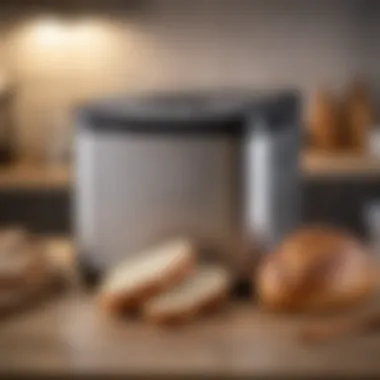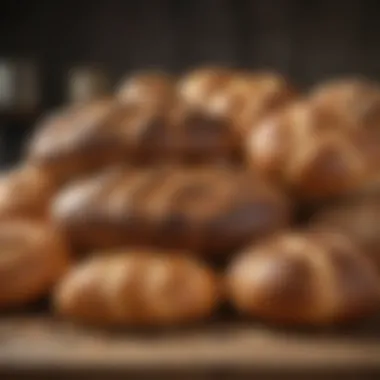Best Low Cost Bread Maker: Affordable Quality Solutions


Intro
In recent years, the popularity of home baking has soared. Many people seek to create their own bread, enjoying the warmth and aroma that fills their homes. With the rise in demand, a range of bread makers has flooded the market, but not all are created equal. For those who desire quality without breaking the bank, low-cost bread makers come into play.
This guide offers a detailed examination of affordable options in the realm of bread making. Readers will find insight into the benefits these appliances bring, the essential features to consider, and a selection of recommended models. The aim is to demonstrate that it is indeed possible to achieve great results in bread-making without a significant financial investment.
The foundation of this piece is to equip food enthusiasts with the knowledge necessary to navigate their options confidently.
Benefits of Low-Cost Bread Makers
A low-cost bread maker can provide several notable advantages:
- Affordability: The primary appeal lies in the price. Many options exist under a reasonable budget, making them accessible to a wider audience.
- Simplicity: These models often boast user-friendly designs, suitable for those who have limited experience in baking. Most require minimal setup and moderate skill.
- Versatility: While inexpensive, many bread makers offer varied settings for different types of bread, catering to diverse preferences.
- Quality: Contrary to some assumptions, many low-cost models still deliver impressive results, allowing users to enjoy fresh, homemade bread.
Essential Features to Look For
When exploring low-cost bread makers, several features are critical to ensuring satisfaction:
- Capacity: Models vary in the quantity of bread they can produce. Consider the household size to determine the best fit.
- Settings and Programs: Look for versatile options such as gluten-free, whole wheat, and various crust settings.
- Kneading and Baking Technology: Check for efficient kneading mechanisms to ensure dough is mixed thoroughly for high-quality bread.
- Ease of Cleaning: Non-stick pans and removable components can streamline the cleanup process.
Recommended Low-Cost Bread Makers
The following models have received favorable reviews:
- Sunbeam Bread Maker: A solid choice with user-friendly controls and various settings for different bread types.
- Hamilton Beach 29882: Offers programmable options and a compact design ideal for smaller kitchens.
- Oster CKSTBRTW20: This model is praised for its double kneading blades, enhancing the dough's texture.
Ending
The journey into home baking need not be fraught with costly investments. Low-cost bread makers present a practical solution for those wishing to dive into the world of baking without financial strain. By recognizing essential features and exploring recommended models, readers can take informed steps toward enhancing their culinary experiences. As you consider embracing this delightful practice, remember that a simple investment can lead to gratifying results.
Preface to Low Cost Bread Makers
The popularity of bread makers has surged as home baking has become more accessible and appealing. Low-cost bread makers provide an affordable entry point for those who wish to explore baking without a large financial investment. Understanding this segment allows consumers to appreciate the balance between cost and functionality. This guide aims to delve into the advantages of these appliances while outlining essential features that distinguish them from high-end models. By focusing on low-cost options, we highlight how bread making can be a fulfilling experience without straining one’s budget.
Definition and Overview
A bread maker is a kitchen appliance designed to automate the process of making bread. These machines handle mixing, kneading, rising, and baking phases, allowing users to create fresh bread with minimal effort. Low cost bread makers typically offer the basic functionalities needed for making different types of bread and sometimes even specialty items like jam and cake.
Their compact size makes them ideal for kitchens with limited space, and many models are user-friendly, requiring just a few ingredients and pushing a few buttons to start.
The Role of Bread Makers in Modern Kitchens
In the contemporary kitchen, convenience plays a significant role in cooking and baking. Low-cost bread makers fit seamlessly into this paradigm. They allow families and individuals to produce quality bread at home without the skills usually required for traditional baking. This accessibility encourages culinary experimentation and grants users control over ingredients. In a world where many people seek healthier alternatives to store-bought bread, the ability to create customized options at home is increasingly valuable.
"Home-made bread not only tastes better but also eliminates preservatives and additives."
Moreover, the ability to produce bread on demand reduces food waste. Consumers can make just the right amount they need, thus minimizing unused loaves sitting on the counter. These appliances exemplify how modern technology can enhance our culinary practices, making bread making an achievable and satisfying task for everyone.
Advantages of Using a Bread Maker
Low cost bread makers offer various advantages that extend beyond simple convenience. For any home baker, understanding these benefits can significantly influence their purchase decision. Bread makers bring a unique value by combining simplicity with effectiveness. They reduce the time and effort typically required for baking while promoting a sense of control over the baking process.
Convenience and Time-Saving
Using a bread maker is fundamentally about convenience. One of the greatest assets of these machines is their ability to automate the bread-making process. Simply add the ingredients, choose the appropriate setting, and start the machine. For those who lead busy lives, this feature is invaluable.


Consider the standard steps involved in traditional bread making: measuring ingredients, kneading dough, letting it rise, and finally baking. Each of these steps can be time-consuming and labor-intensive. A bread maker consolidates these tasks into one appliance, reducing preparation time significantly. Many models come with pre-programmed settings for different types of bread. This allows one to bake a variety of bread with minimal effort.
"With a bread maker, the act of creating bread becomes less about time-consuming techniques and more about enjoyment of fresh bread."
Control Over Ingredients
Another significant advantage of using a bread maker is the control it gives over ingredients. For health-conscious individuals or those with dietary restrictions, this control is paramount. You can select the flour type, alter the sugar content, or even add ingredients like nuts or seeds. This personalization is not typically available when purchasing pre-made breads.
Moreover, many store-bought breads contain preservatives and additives that can affect taste and health. Having a bread maker empowers users to avoid these unwanted ingredients. You can experiment with gluten-free options or organic ingredients tailored to your specific dietary needs. This control enhances not just dietary satisfaction but also the overall quality of the bread.
Consistency in Results
Consistency is often the hallmark of successful baking. Many bakers struggle to achieve reliable outcomes when making bread by hand. Variations in temperature, humidity, and even ingredient quality can lead to inconsistent results. A bread maker helps mitigate these factors. They come equipped with heat and timing mechanisms designed for optimal results.
Most machines offer a controlled environment that adjusts to ensure proper kneading and rising. This consistency means that you can expect similar results every time you process dough. For anyone focused on perfecting their baking skills, the reliability of bread makers offers both encouragement and efficiency.
By utilizing a bread maker, the user not only saves time but also enhances the overall experience of bread making. Each of these advantages contributes to a favorable foundation for a great home baking experience.
Features to Look for in a Low Cost Bread Maker
Finding the right low-cost bread maker involves understanding specific features that enhance both functionality and user experience. When evaluating options available on the market, it’s crucial to focus on how these features align with your baking needs and habits. Low-cost doesn’t mean compromising on quality or usability.
Capacity and Size
The capacity of a bread maker often dictates how much bread it can produce in one cycle. Most models range from 1 to 2.5 pounds. If you typically bake for a larger family, consider a model that offers a larger capacity. Smaller units, on the other hand, are suitable for individuals or couples. Additionally, size plays a critical role when considering countertop space. It's significant to balance between the machine's capacity and the storage space available in your kitchen.
Programmable Settings
Programmable settings are essential in creating various types of bread with ease. Many low-cost models come equipped with several pre-set programs, such as basic, whole grain, French, and sweet bread options. This feature allows for customization with just a few button presses, minimizing the need for constant supervision. Moreover, the ability to set a timer helps in planning fresh bread for breakfast or dinner without requiring early morning preparation. Having these settings can elevate everyday baking into a more enjoyable process.
Versatile Baking Options
Versatility is a key consideration. Look for models that not only bake traditional white bread but also allow for gluten-free, sourdough, or artisan bread. Some low-cost bread makers even have settings for making jams, cakes, and pizza dough. This variety can expand your baking repertoire, offering different types of bread and other baked goods. A broader selection can make the purchase more worthwhile and improve the use of the machine over time.
Ease of Use and Maintenance
It's paramount that any bread maker you choose is user-friendly. Look for clear instructions that guide you through the baking process. Features such as a large viewing window and an easy-to-read display enhance usability. In addition, the cleaning aspect should not be overlooked. Models with a non-stick baking pan are generally easier to clean. Regular maintenance entails not only cleaning the pan but also ensuring other parts are free from buildup to extend the life of your appliance.
To summarize, understanding the features available in low-cost bread makers can significantly affect your baking experience. Key aspects like capacity, programmable settings, versatility, and maintenance ease should guide your purchasing choice.
Top Low Cost Bread Makers on the Market
When considering the best low cost bread makers, it is vital to acknowledge their growing significance in the home baking landscape. These appliances not only streamline the bread-making process but also make high-quality bread accessible for those on a budget. Low cost does not equate to subpar performance; rather, it highlights how various brands are innovating to provide functionality that meets consumers' needs without stretching their finances. This section will explore some key elements associated with top low cost bread makers, offer comparisons of specific models, and highlight options that deliver great value for money.
Model Reviews and Comparisons
In this segment, we will analyze various models that stand out in the low-cost category. Each model available has unique features catering to different baking styles and preferences. For example, the Breadman BK1050S offers a convection feature that allows air to circulate, resulting in a more evenly baked loaf. Contrastingly, the Hamilton Beach 29882 is known for its user-friendly settings and larger capacity, which makes it perfect for families or those who like to bake in bulk.
To make informed decisions, consider factors such as:
- Capacity: Evaluate how much bread you typically consume.
- Settings: Look for programmable options and pre-set cycles.
- Bread crust settings: Some models let you choose the level of crustiness you prefer.
Reviews indicate that the Oster CKSTBRTW20 offers a remarkable balance of affordability and quality, often receiving favorable reviews for its performance and durability. Comparisons of these models will give readers clarity on which appliance suits their specific requirements.
Best Value for Money Models


Finding a bread maker that provides excellent value for money is a priority for many buyers. Panasonic SD-YD250 is often lauded for its robust bread-making capabilities at a reasonable price point. This model combines versatility and ease of use, making it a great contender in the low-cost market.
Another notable mention is the Sunbeam 5891, which is equipped with useful features such as a delay timer and multiple loaf sizes, while still being budget-friendly. For those specifically looking for gluten-free baking options, Cuisinart CBK-200 stands out as an excellent choice, ensuring that all dietary preferences are accommodated without compromising on taste or texture.
"A good bread maker should not only be easy to use, but it should also provide a variety of options to satisfy different tastes and needs."
Weigh your options carefully, considering long-term utility versus initial cost. Ensuring the model you select meets your specific needs can enhance your overall baking experience.
How to Choose the Right Bread Maker for Your Needs
Selecting the right bread maker is essential for achieving your desired baking results. The options available in the market can be overwhelming due to the different functionalities, sizes, and price ranges. Understanding your specific needs can simplify the decision-making process. This section discusses critical elements to consider when selecting a bread maker that aligns with your culinary aspirations.
Assessing Your Baking Habits
Consider your baking habits before diving into the various models. Assess how often you plan to bake bread and the types of bread you intend to create. If you enjoy frequent baking or experimenting with diverse recipes, a more versatile machine might be necessary. Look for a model that supports whole grain, gluten-free, and artisanal bread settings. These models often provide advanced features such as adjustable crust choices or custom settings for unique recipes.
Additionally, think about the quantity of bread you typically consume. If you are baking for a large family or entertaining guests regularly, a machine with a larger capacity is beneficial. For an individual or small household, a compact machine suffices.
Budget Considerations
Budget also plays a significant role in your choice of a bread maker. Low-cost bread makers can range from as low as $50 to several hundred dollars. It is crucial to set a limit based on your financial capability, but also consider durability and performance. Investing in a slightly higher-priced model often means better material and technology, providing more years of service.
When assessing cost, think about the value beyond the purchase price. A low-cost bread maker might save you money initially, but if it requires frequent repairs or replacements, it may end up costing more in the long run. Look for models that balance initial cost with reliability and functionality.
"A well-thought-out investment ensures not just the delight of fresh bread but also the satisfaction of made-quality kitchen appliance that will stand the test of time."
Tips for Successful Bread Making
The process of bread making is both an art and a science. To achieve the perfect loaf using a bread maker, certain principles must be followed. Key aspects such as understanding ingredients, adhering to recipes, and troubleshooting common issues can significantly impact the outcome. This section explores these topics in detail, creating a foundation for producing high-quality bread at home.
Understanding Ingredients
The quality of ingredients plays a vital role in bread making. First, differentiate between various types of flour. All-purpose flour is commonly used, but bread flour provides more gluten, resulting in a chewier texture. Whole wheat flour adds nutritional value and flavor, though it requires more hydration.
Yeast is another critical component. Instant yeast activates quickly and works well in most bread makers, while active dry yeast requires proofing. For those sensitive to gluten, using specialized gluten-free flour blends is essential.
Other ingredients such as salt, sugar, and fats also influence flavor and texture. Salt enhances taste and controls yeast activity. Sugar feeds the yeast and provides sweetness, while fats like butter or oil contribute to tenderness.
Following the Recipes Accurately
Recipes serve as guidance in the bread-making journey. Accurate measurement of ingredients is crucial. Using a kitchen scale can improve precision, reducing the chance of errors that affect the loaf's structure.
Bread machines often come with recipe books tailored for specific models. Following these recipes ensures compatibility with the machine’s settings. It’s important to add ingredients in the order specified. For most makers, liquids should be added first, followed by dry ingredients and yeast on top, avoiding direct contact with salt.
"Precision in measuring ingredients is key to achieving consistent results in bread making."
Adaptations can be made based on personal preference, but significant changes should be approached cautiously to maintain the right balance in the mixture.
Common Troubleshooting Techniques
Even seasoned bakers encounter issues. Understanding common problems allows you to make necessary adjustments. Here are a few frequent challenges:
- Bread Not Rising: Possible causes include expired yeast or incorrect temperatures of liquids. Always check the expiration date and ensure liquids are warm but not hot.
- Dense Bread: Often results from too much flour. Adjusting the flour quantity while following measurements accurately may remedy this.
- Burned Crust: If the crust is too dark, consider using a smaller loaf size or adjusting the baking settings on your bread maker.
Being able to identify these problems can lessen frustration and improve the overall baking experience. With practice, users can develop a keen sense for what adjustments to make per their specific environment.


Cleaning and Maintaining Your Bread Maker
Maintaining the functionality and longevity of your bread maker is essential for ensuring that it continues to produce quality baked goods. A clean bread maker not only ensures better performance but also reduces the risk of contamination. Regular cleaning helps in avoiding any buildup of flour, dough, or other residues that could affect the next baking session. Moreover, proper maintenance can extend the life of the device, saving you money in the long long run.
Regular Maintenance Tips
To keep your bread maker in top condition, consider the following tips:
- Read the Manual: Every bread maker is unique. Understanding the specific requirements for your model is crucial.
- Wipe Down the Exterior: After each use, use a damp cloth to clean the exterior. This helps prevent dust and grime accumulation.
- Check the Paddle: The kneading paddle should be cleaned and checked for damage. Remove any dough residues after use to ensure it operates smoothly in the next cycle.
- Inspect the Baking Pan: Make sure to check for wear and tear on the baking pan. A damaged pan can affect the baking results.
- Store Properly: When not in use, store the bread maker in a dry place to prevent moisture damage.
Deep Cleaning Procedures
For a more thorough clean, implement these deep cleaning procedures at least once a month:
- Disassemble Carefully: Follow the manufacturer's instructions to detach the baking pan and kneading paddle.
- Soak the Components: Soak the baking pan and paddle in warm, soapy water. This helps to break down any stuck-on dough or residue.
- Avoid Abrasives: Use a soft sponge or cloth to clean the surfaces. Avoid abrasive materials that could scratch non-stick coatings.
- Rinse and Dry: After cleaning, rinse all components well to remove soap residue. Allow them to air dry completely.
- Clean the Heating Element: Carefully wipe the heating element and interior using a damp cloth. Be cautious not to use too much liquid.
Proper maintenance and cleaning of your bread maker can enhance its efficiency and help produce high-quality bread.
By being diligent with regular maintenance and thorough cleaning, you ensure that your bread maker continues to meet your baking needs. Countless delicious loaves depend on these simple practices.
Frequently Asked Questions About Bread Makers
When considering a purchase of a bread maker, potential buyers often have similar concerns and inquiries. This section addresses common questions that arise regarding bread makers, particularly those that are low cost. By exploring these questions, we can understand how these machines fit into the everyday lives of baking enthusiasts and home cooks alike.
Understanding these frequently asked questions is crucial for making informed discussions. It can alleviate concerns, clarify functionalities, and highlight the versatility of bread makers.
What is the average lifespan of a bread maker?
The lifespan of a bread maker typically ranges from 5 to 10 years, depending on various factors such as brand, usage, and maintenance. A well-maintained bread maker can serve reliably for longer periods. High-quality models from brands like Panasonic or Cuisinart have built a reputation for durability, often lasting the full decade if treated with care.
Manufacturers often provide guidance in their manuals, outlining proper usage, care, and maintenance practices that help prolong the life of the machines. Regular maintenance includes simple tasks like cleaning the pan and the kneading blade, which directly affects performance. Moreover, proper handling during use can prevent damages such as overheating or misalignment.
Can make gluten-free bread in these machines?
Yes, many low-cost bread makers come equipped to handle gluten-free bread recipes. However, it is essential to choose a model that explicitly mentions gluten-free options in its specifications or user manual. Using a bread maker that includes pre-programmed gluten-free settings simplifies the process, ensuring that the bread achieves the desired texture and taste.
Baking gluten-free bread generally requires different ingredients, such as gluten-free flour blends and binders. It’s advisable to follow recipes designed for gluten-free baking to attain the best results. Additionally, reviewing customer feedback on specific models can provide insights into how effectively they perform gluten-free baking, helping to guide your purchase decision.
"The right bread maker can make the gluten-free baking process surprisingly easy, opening doors to opportunities for more creative and healthy cooking."
End: The Value of Low Cost Bread Makers
In the exploration of low-cost bread makers, it is essential to understand their significance in today’s culinary landscape. With rising interest in home baking, these machines serve as accessible tools for producing fresh bread. Their affordability means that quality does not have to be sacrificed for price. By prioritizing low-cost options, bakers of all skill levels can enjoy homemade bread, enhancing their kitchen experience without substantial financial investment.
The benefits that low-cost bread makers offer extend beyond just affordability. They provide convenience and efficiency. Individuals can automate the bread-making process, allowing for consistent results with less manual effort involved. Moreover, many models come equipped with automatic settings and programmable features, thus catering to diverse baking preferences.
Consider the role of these devices in promoting healthier eating habits. Home bakers have the advantage of controlling ingredients. They can experiment with organic flours, gluten-free options, or other nutritious elements. This flexibility attracts health-conscious individuals who want to ensure they are consuming quality products.
*
"Investing in a low-cost bread maker opens doors to creativity in the kitchen, while also promoting well-being through thoughtful ingredient choices."
*
Overall, low-cost bread makers can be a powerful ally in both culinary and personal health goals. As seen throughout this guide, the right model can accommodate various preferences and baking demands, enriching the home baking experience.
Final Thoughts on Affordability and Quality
As we wrap up our discussion, the contrast between affordability and quality in bread makers emerges as a central theme. Affordable models do not often compromise on essential functionalities. Instead, they empower users to create bakery-worthy products in their own homes. Brands such as Oster and Hamilton Beach provide cost-effective options that have been well-received by consumers.
Moreover, the shift towards home baking continues as a trend that resonates with many. This movement, alongside technological advancements, minimizes the barriers that once existed in bread making. Given such availability, individuals can appreciate the craft of baking without financial strain.







